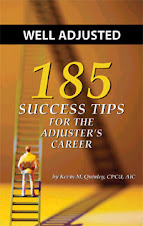As talented as they may be in handling claims, many claim adjusters are not tuned in to loss prevention. They handle a claim, settle a case, close their file, submit their bill, and move on to the next case. There may be any number of reasons why claims people – even very good claims people – are reluctant to offer loss control feedback. Here are three:
• They are often just too darned busy to do much beyond handling the claim. Spending time trying to pan for nuggets of loss prevention “gold” can seem like a luxury they cannot afford. Dabbling in loss control may seem like a frill or an intrusion, adding to their list of already daunting job duties. Let’s just get the case settled, close the file and move on!
• Some may feel that this is just not in their job description
• They may feel they lack the expertise: “I’m not a `safety person’ – where do I come off giving loss control advice?”
Ideally, adjusters can offer a post-mortem, advising the client on how such an accident or claim can be averted in the future. In reality, time and cost pressures militate against this type of synergy between claims adjusting and loss prevention.
Furthermore, an adjuster's familiarity with any one account is limited, so the opportunities for meaningful loss prevention insights are often lost. Cynics could also argue that loss prevention is not in the economic self-interest of the claims adjuster. When you get paid by the loss, you want more losses. Or, at least you may not work too hard to prevent them.
The in-house adjuster, however, can be an invaluable aid with regard to loss prevention. They are more familiar and up-close with the situations spawning claims. They can take a more long-term outlook than the outside adjuster, who may handle only two claims for a risk manager in any given year. The in-house adjuster, to be sure, does not want to work himself out of a job, but does have a vested interest in stemming the tide of rising claims. Thus, in-house adjusters can be counted on to a greater extent to provide "nuggets" of loss prevention wisdom which can help the risk manager improve her bottom line.
This is not to say that we are trying to remake adjusters into loss control specialists or to turn them into something that they are not. Having said that, there are many instances where adjusters can add value to a safety program by alerting management to conditions which, if corrected, can lower loss frequency or severity. In an insurance company context, adjusters might give such feedback to underwriters. In a self-insured or in-house claims context, this “intel” can go to upper manager and safety personnel.
However, when a corporation internalizes the claims function, adjusters see operations on a recurring basis and can hone their ability to spot situations that can create future claims or make such claims more expensive. In such situations, in-house adjusters can directly reach the ear of management by giving feedback such as:
• “We are saying an uptick in low back strains. Perhaps we should invest more in training workers on proper of lifting techniques or providing abdominal belt supports.”
• “We are experiencing a 20% increase in repetitive stress injuries and claims for carpal tunnel. Perhaps we need an ergonomic redesign of those employees’ workflows.”
• “While visiting our Dayton facility, I noticed debris on the floor which could create a slip and fall hazard…”
• “Four company vehicle accidents over the past year have involved distracted driving. Perhaps we need to retool corporate policy with regard to texting and cell phone use while behind the wheel of company cars…”
Having in-house adjusters may help the claim professional identify more with the ultimate client and hone specialized expertise that enables claims people to spot little problems and trends before they become BIG problems.
Subscribe to:
Post Comments (Atom)






No comments:
Post a Comment